| |
Our Illustrators
As stated on our home page, where possible our editors have selected illustrated editions available in Tolkien's lifetime - books that would have adorned Tolkien’s bookshelf. Both texts and pictures have been reproduced, and our books are mostly copies of the editions the professor held in his own hands.
The illustrated story-books that were so popular during Tolkien's lifetime must have influenced him profoundly. Illustrations and graphic ornamentation add a great deal to the way a story is told. If the pictures were removed, the experience of reading a story would not remain the same.
|
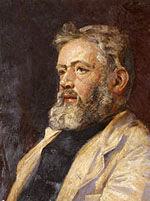
|
William Gershom Collingwood (1854 -1932)
Collingwood was an English author, artist, antiquary and Professor of Fine Arts at University College, Reading.
By the 1890s Collingwood had become a skilled painter and also joined the Cumberland and Westmorland Antiquarian and Archaeological Society. He wrote a large number of papers for its Transactions; becoming editor in 1900. Collingwood was particularly interested in Norse lore and the Norsemen, and he wrote a novel, Thorstein of the Mere which was a major influence on Arthur Ransome.
In 1897, Collingwood travelled to Iceland where he spent three months over the summer exploring with Jón Stefánsson the sites around the country in which the medieval Icelandic sagas are set. He produced a large number of sketches and watercolours during this time (e.g. the picture of the Althing), and published, with Stefánsson, an illustrated account of their expedition in 1899 under the title A Pilgrimage to the Sagasteads of Iceland (Ulverston: W. Holmes).
Collingwood was a member of the Viking Club and served as its president. In 1902 he co-authored again with Jón Stefánsson the first translation it published, The Life and Death of Kormac the Skald. His study of Norse and Anglican archaeology made him widely recognized as a leading authority.
|

|
Walter Crane (1845–1915)
Walter Crane was an English artist and book illustrator. He is considered to be the most prolific and influential children’s book creator of his generation and, along with Randolph Caldecott and Kate Greenaway, one of the strongest contributors to the child's nursery motif that the genre of English children's illustrated literature would exhibit in its developmental stages in the latter 19th century.
His work featured some of the more colourful and detailed beginnings of the child-in-the-garden motifs that would characterize many nursery rhymes and children's stories for decades to come. He was part of the Arts and Crafts movement and produced an array of paintings, illustrations, children's books, ceramic tiles and other decorative arts. |

|
Henry Justice Ford (1860–1941)
Henry Justice Ford was a prolific and successful artist and illustrator, active from 1886 through to the late 1920s. Sometimes known as H. J. Ford or Henry J. Ford, he came to public attention when he provided the numerous beautiful illustrations for Andrew Lang's Fairy Books, which captured the imagination of a generation of British children and were sold worldwide in the 1880s and 1890s.
In 1892, Ford began exhibiting paintings of historical subjects and landscapes at the Royal Academy of Art exhibitions. However it was his illustrations for such books as The Arabian Nights Entertainments (Longmans 1898), Kenilworth (TC & EC Jack 1900) and A School History of England' by Charles Fletcher and Rudyard Kipling (Clarendon Press 1911) that provided Ford with both income and fame.
|

|
Keith Henderson (1883–1982)
Keith Henderson trained at the Slade and was an official war artist with the RAF. Known primarily as an illusttrator, he illustrated works by E. R. Eddison, W. H. Hudson and, with Norman Wilkinson, a famous edition of Chaucer's translation of The Romaunt of the Rose. These illustrations received very favorable reviews from the critics. |
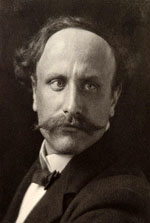
|
William Brown MacDougall (1868-1938)
From Wikipedia: 'Born in Scotland, W. B. Macdougall was a British artist, wood engraver, etcher and book illustrator. His wife was Margaret Armour, the noted novelist, translator, poet and playwright. They collaborated with famous Art Nouveau artist Aubrey Beardsley on many projects and were members of the prestigious New English Art Club.
'Macdougall received his art education at the Glasgow Academy and at the Académie Julian in Paris, also becoming a member of the Salon des Artistes Français. His work tended to be somewhat sombre and was clearly influenced by Aubrey Beardsley and William Morris. He provided a frontispiece portrait of Robert Louis Stevenson for Margaret's first book, and illustrations for her books of poetry as well as her translations from medieval German.
'He only illustrated for a very brief period between 1896 and 1898, but contributed greatly to this form of art. His beautiful drawings that adorn 'The Fall of the Nibelungs', 'Isabella, or the Pot of Basil' and 'The Blessed Damozel' owe much to Art Nouveau and Arts and Crafts Movement motifs. He also painted in oils and other mediums.
MacDougall's work is also published in 'The Eerie Book' (London: J. Shiells and Co., 1898), edited by Margaret Armour, 'The Fields of France' (London: Chapman and Hall, 1905), by A. Mary F. Robinson, 'The Chronicles of Strathearn' (David Philips, Scotland, 1896) by 'Various', 'The Book of Ruth', Pictured and Designed by W.B. Macdougall, and 'The Blessed Damozel,' by
Dante Gabriel Rossetti, (London: Duckworth & Co. 1898.)
After William's death in 1936 Margaret returned to Edinburgh where she died in 1943. They had no children.
|
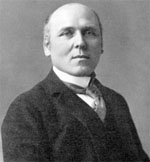
|
Howard Pyle (1853-1911)
Howard Pyle (March 5, 1853 – November 9, 1911) was an American illustrator and author, primarily of books for young people. A native of Wilmington, Delaware, he spent the last year of his life in Florence, Italy.
In 1894 he began teaching illustration at the Drexel Institute of Art, Science and Industry (now Drexel University). After 1900, he founded his own school of art and illustration, named the Howard Pyle School of Illustration Art. The scholar Henry C. Pitz later used the term Brandywine School for the illustration artists and Wyeth family artists of the Brandywine region, several of whom had studied with Pyle.[1] Some of his more notable students were N. C. Wyeth, Frank Schoonover, Elenore Abbott, Ethel Franklin Betts, Anna Whelan Betts, Harvey Dunn, Clyde O. DeLand, Philip R. Goodwin, Violet Oakley, Ellen Bernard Thompson Pyle, Olive Rush, Allen Tupper True, Elizabeth Shippen Green, and Jessie Willcox Smith.
His 1883 classic publication The Merry Adventures of Robin Hood remains in print, and his other books, frequently with medieval European settings, include a four-volume set on King Arthur. He is also well known for his illustrations of pirates, and is credited with creating what has become the modern stereotype of pirate dress.[2] He published his first novel, Otto of the Silver Hand, in 1888. He also illustrated historical and adventure stories for periodicals such as Harper's Weekly and St. Nicholas Magazine. His novel Men of Iron was adapted as the movie The Black Shield of Falworth (1954).
Pyle travelled to Florence, Italy in 1910 to study mural painting. He died there in 1911 of a sudden kidney infection (Bright's Disease)
|
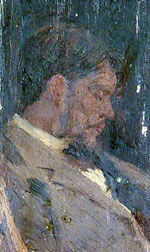
|
Sidney Syme (1867 – 1941) Sidney Sime, often known as S.H. Sime, was an English artist in the late Victorian and succeeding periods, mostly remembered for his fantastic and satirical artwork, especially his story illustrations for Irish author Lord Dunsany. Sime was born in Manchester in poverty. After a five-year career in the mines, including as a "scoop pusher," work at a linen shop, a barbers, and as a signwriter (setting up in his own right), he studied at the Liverpool School of Art (later "College", then joined the University of Liverpool in 1952). During his time at college, he won a South Kensington medal. He is sometimes called "the biggest thing to come out of Liverpool before the Beatles."
Sime quickly became famous for drawings and illustrations with fantastic themes, with a presence in Pick-Me-Up, The Idler and the Pall Mall Gazette. The fantastic treatment often masked biting satire, especially aimed at the rich and at politicians. He received an inheritance after an uncle died and bought The Idler, but the business failed in under two years.In 1904, Sime was approached by the author for whom he is most often remembered, Irish aristocrat Lord Dunsany, to illustrate his first book, 'The Gods of Pegana', finally published in 1905. This began an association which lasted for the rest of his life, with his illustrations especially prominent in Dunsany's earlier work (until c. 1922). For one volume, at least some of the stories were inspired by Sime works (The Book of Wonder), and for three, in special limited editions, each plate of illustration was signed by both author and artist.
|

|
Lancelot Speed (1860–1931)
Lancelot Speed was a famous Victorian illustrator of books, usually of a fantastical or romantic nature. He is probably most well known for his illustrations for Andrew Lang's fairy story books.
Speed is credited as the designer on the 1916 silent movie version of the novel 'She' by H. Rider Haggard, which he had illustrated. He was also the director of a number of early British silent films.
His bibliography includes -
'By Roaring Loom' (London: James Bowden, 1898), by Marshall Mather
'If Youth But Knew!' (New York: Macmillan, 1906), by Agnes Castle and Egerton Castle
'In the Mahdi's Grasp', by George Manville Fenn, also illust. by Edward F. Skinner
'Stirring Tales of Colonial Adventure' (London and New York: F. Warne and Co., 1894), by James Skipp Borlase
'Aspects of Modern Oxford', by A. D. Godley, also illust. by J. H. Lorimer, T. H. Crawford, and E. Stamp
'The Legends of King Arthur and His Knights', by Thomas Malory and James Knowles
'Tales of Romance', ed. by Andrew Lang, also illust. by H. J. Ford
'Tom Wallis': A Tale of the South Seas, by Louis Becke.
|
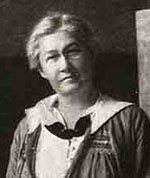
|
Jessie Wilcox-Smith (1863 – 1935)
From Wikipedia: 'Jessie Willcox Smith was one of the most prominent female illustrators in the United States during The Golden Age of Illustration. She is most notable for her work in magazines such as 'Ladies' Home Journal' and'Good Housekeeping', and for her illustrations of many children's books.
Born in Pennsylvania, Smith attended private elementary schools. At the age of sixteen she was sent to Cincinnati, Ohio, to finish her education. She had originally trained to become a teacher, securing a position teaching kindergarten in 1883, but found that she could not cope with the strenuous demands of working with children. After being persuaded to join her cousin in art classes, Smith realized she had a talent for drawing and quit her teaching job to pursue a degree in art.
In 1884 she attended the School of Design for Women (which is now Moore College of Art & Design) and later studied at the Pennsylvania Academy of the Fine Arts under Thomas Eakins in Philadelphia. It was studying under Eakins that Smith began to utilize photography as a resource in her illustrations, and he became one of her first major influences.
After graduating the Pennsylvania Academy of the Fine Arts in 1888, Smith joined Ladies Home Journal in the advertising department as a means to support herself. The job itself was entry-level and consisted of Smith finishing rough sketches, designing borders, and preparing advertising art for the magazine.
It was during this time at the magazine that Smith realized she needed more experience in her craft. in 1894 she enrolled in Howard Pyle's classes at Drexel University. Pyle pushed many artists of Smith's generation to fight for their right to illustrate for the major publishing houses of the time and worked especially close with many artists who he himself saw as 'gifted'. Smith herself stated in a speech she gave about Pyle, that working with him swept away 'all the cobwebs and confusions that so beset the path of the art-student.'
Smith was a prolific contributor to books and magazines during the late nineteenth and early twentieth centuries, illustrating stories and articles for clients such as Century, Collier's Weekly, Leslie's Weekly, Harper's, McClure's, Scribners, and the Ladies' Home Journal. Smith may be most well known for her covers on Good Housekeeping, which she painted from December 1917 through March 1933. She also painted posters and portraits for various companies. Her twelve illustrations for Charles Kingsley's The Water-Babies (1916) are also well known. On Smith's death, she bequeathed the original works to the Library of Congress' "Cabinet of American Illustration" collection. A thirteenth illustration remains in a private collection.
The Hall of Fame of the Society of Illustrators has inducted only 10 women since its inception in 1958. Smith was the second after Lorraine Fox. Of those ten, three of them occupied the same house, Cogslea, as the Red Rose Girls. Elizabeth Shippen Green and Violet Oakley were fellow Howard Pyle students who shared that space, which was arguably the finest assembly of illustrative talent ever in American life. Smith's papers are deposited in the collection of the Pennsylvania Academy of the Fine Arts.
|
|